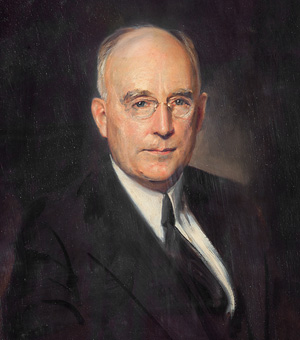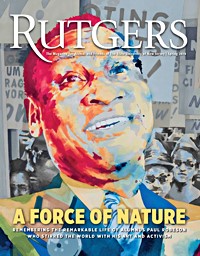John Martin Thomas
Rutgers President, 1925 to 1930

John Martin Thomas was born in Fort Covington, New York, a graduate of Middlebury College and the Union Theological Seminary in New York City. He served as pastor of the Arlington Avenue Presbyterian Church in East Orange, New Jersey, from 1893 to 1908. In 1908, at the age of 39, he became president of Middlebury College and served at the Vermont school until 1921, when he became president of the Pennsylvania State College. He left Penn State in 1925 to become president of Rutgers.
Thomas’s five-year reign at Rutgers was marked by a period of growth and expansion in student enrollment, academic programs, and physical facilities; it was also a time of increased frustration over relations with the State. In 1925, when he assumed the presidency, Rutgers had 1,343 undergraduates and a total registration of 2,396. By 1930 the undergraduate population had increased to 2,662, and combined enrollment in the university was nearly 17,000 students. In 1925, the University Extension Division was established, providing educational service to over 40,000 residents of New Jersey. The following year Thomas invited the Bureau of Education to conduct an extensive survey of the university and submit a detailed report, which was used to develop long-range plans for the institution. As a result of the study, faculty salaries were increased and four-year courses in economics and business administration were added to the curriculum. In January 1927, the New Jersey College of Pharmacy in Newark was incorporated into the university, and in the same year the Bureau of Biochemical and Bacteriology Research was established. By 1930, the university consisted of seven schools and colleges: Arts and Sciences, Engineering, Agriculture, Education, the New Jersey College for Women, Pharmacy, and Chemistry.
Expansion marked John Martin Thomas’s presidency. In 1925, the University Extension Division was established, providing educational service to over 40,000 residents of New Jersey.
With the growth of new academic programs came new facilities. The Dramatic Arts Building was completed in 1925, and one year later, Hegeman Hall, an addition to the Voorhees Library, and Van Dyck Hall. Construction at the women’s college included Recitation Hall and the Voorhees Chapel in 1926, and the Willets Infirmary and the Music Building in 1928. In 1929 three dormitories—Wessells, Leupp, and Pell Halls—were begun on the Bishop Campus.
Throughout his term, Thomas and the trustees deliberated over the university’s relationship with the State of New Jersey. State appropriations had not amounted to the levels needed to expand the school into a state university, and the problem remained over the dual private-public role of Rutgers. By 1930, numerous attempts to resolve the differences had failed and on September 19, 1930, Thomas announced his resignation as president of Rutgers University. He had championed the idea of Rutgers becoming a state university but he had become discouraged with the lack of results. Upon his resignation he assumed the vice presidency of the National Life Insurance Company in Montpelier, Vermont. He later became acting president of Norwich University. The trustees of Rutgers University named Philip M. Brett, devoted trustee and a graduate of Rutgers College, Class of 1892, as acting president. On February 26, 1952, John Martin Thomas died, at the age of 82, in Rutland, Vermont.
This biographical sketch was authored by Thomas J. Frusciano, Rutgers University Archivist. It originally appeared in The Journal of the Rutgers University Libraries.

